
The first two California counties received state approval Tuesday to more quickly reopen some services as state officials gradually relax restrictions aimed at slowing the spread of the coronavirus.
The California Department of Public Health posted documents from Butte and El Dorado counties on its website with a note that “These counties can move more quickly through Stage 2 opening sectors once state guidance is posted for that sector.”
Both are located in the Sierra Nevada foothills. Health officials in each county attested that they have had little local impact from the pandemic.
Gov. Gavin Newsom on Tuesday was expected to outline new areas that can begin reopening with less restrictions, such as allowing restaurants to begin seating customers instead of only offering take-out food.
The state will allow counties to go beyond the state’s plan, but only if they meet strict standards that include no coronavirus-related deaths and no more than one confirmed case per 10,000 residents in the past two weeks.
Newsom also said his administration has discussed plans with 19 counties, with nine others scheduled. Some could have their plans approved by Tuesday. But it’s been difficult for some more populated counties to meet those state standards.
The developments come as many local governments continue pushing for a swifter reopening, and as restaurants rushed to prepare for serving fewer customers at tables separated to minimize the chance of spreading the coronavirus.
Many restaurants already are practicing safety procedures they anticipate will be required once they open to sit-down dining for the first time in two months.
Raechel Kadoya, owner of Soichi Sushi in San Diego, says she spent about $3,000 for a new air purification system using ultraviolet light and filters. The restaurant also now has custom shield guards between the sushi bar patrons and the chef. The kitchen staff wear masks.
“We work in the food industry so safety, cleanliness, that’s top of the list,” she said. “We’re thinking on our own, without guidelines, about what we can do to make it safer.”
Coronavirus Deaths in Your City and State — and Across the US
These charts use daily coronavirus death data from Johns Hopkins University to show the seven-day moving average of deaths at the city, state and country level.
The impact of coronavirus varies enormously in the United States from one place to another.
Source: Johns Hopkins University.
Credit: Visuals by Amy O’Kruk/NBC, data analysis by Ron Campbell/NBC
Other restaurants are doubling down on sanitizing seats, surfaces and doorknobs and removing tables to ensure social distancing.
Reopening restaurants is likely to be a disjointed process, with those in rural areas opening first, and eateries in Los Angeles, San Francisco and other urban areas remaining closed longer.
The California Restaurant Association has drafted recommendations that include limiting tables to no more than 10 people. Salad bars, buffets and shared bread baskets would be out.
In the Los Angeles suburb of Duarte, Leon Avakian says he’d like to reopen by June — he only just broke even in April after the closure began to bite. Avakin said he expects new safety guidelines to be in force for a year or more, or until a vaccine is developed.
“I’m a pharmacist by training and I’ve worked in the health field for about 20 years,” he said. “I understand that these changes are necessary.”
Depending on their size, restaurateurs are hoping that they can retain 25% or 50% or more of their old seating capacity. However, the association hoped the state would avoid setting an across-the-board percentage limit on occupancy.
“Our revenue is less than 20% of normal. We’re barely able to keep our head above water,” said Richard Yates, co-owner of Opal Restaurant & Bar in Santa Barbara.
But it’s not all about money, he said. Takeout customers can get lemongrass crusted fresh salmon or shredded phyllo-wrapped tiger prawn but they can’t get the dining experience “eating them in a little box at home,” Yates said. “Being a full-service restaurant, it’s in our blood to have full contact with people.”
Restaurant reopenings have become symbolic of the thorny problems of trying to jump-start the economy. Under Newsom’s reopening plan, it could be weeks or even a month before restaurant dining rooms are allowed to reopen.
But Yuba and Sutter counties in Northern California, which have had few virus cases, already have defied the governor by allowing dine-in restaurants to reopen, along with hair salons and gyms.
More than two dozen counties have asked for permission to loosen their stay-at-home orders beyond what the state allows, Newsom said Monday, promising a speedy review.
San Diego County said in its letter to Newsom Monday that it was requesting “autonomy to reopen additional economic sectors based on clear, consistent, and achievable metrics.” It said some criteria, such as no COVID-19 deaths for 14 days, were unrealistic for large counties.
The county cited sustained progress in responding to the outbreak and extensive planning by business and labor leaders in creating plans for safely reopening their sectors.
California has more than 68,000 confirmed coronavirus cases and more than 2,700 deaths, according to data compiled by Johns Hopkins University. The number of infections is thought to be far higher because of a shortage of testing.
For most people, the new coronavirus causes mild or moderate symptoms, such as fever and cough that clear up in two to three weeks. For some, especially older adults and people with existing health problems, it can cause more severe illness, including pneumonia and death.



